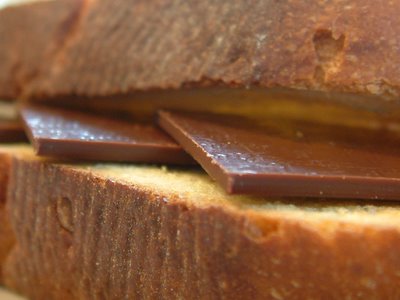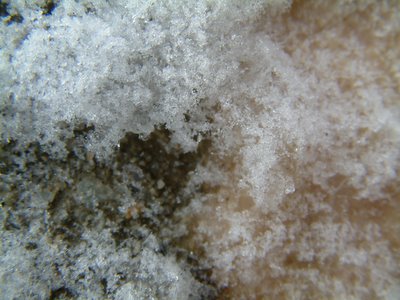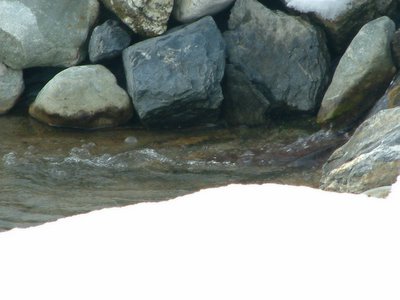Blog etiquette
Maki in Zurich, a longtime blogger, caught me red-handed the other day. I was changing a post for about the fifth time. Sixth? It was a bad day. I couldn't spell or get the grammar right. My ideas were too fuzzy, so I kept rearranging them. This is not good news for someone who teaches writing and is the author of a book on how to write well. I have a golden rule that you set editing limits and stop when you reach them. Not that day, though.
I had a niggling sense that maybe this could create problems for people who read blogs. I promptly forgave myself: I'm new to this.
But Maki pointed out, in a sensible post on etiquette in the blogosphere, that doing a few things the right way makes it easier, and nicer, for other people. She is very civilized and writes about (better yet, photographs) good meals when she is not writing about technology. I'm inclined to listen to her, after viewing the duck and potato meal she just put together.
Her comments remind me of conversations at the dinner table (mine, yours, our mothers'. anyone's) about why we chew with our mouths closed and why we don't spit out our food and so on. Nicer for the guy who is across from you, and not really more trouble for you.
The first bit of advice she offered is this: for corrections that go further than obvious spelling mistakes, note that you are making a change. Don't just change it. She does a good job of explaining why, which I won't repeat here. Her second bit of advice: don't just delete posts. They are still out there, if anyone has already accessed them.
They used to be called visiting cards
There lies the rub. I haven't quite worked out how I access yours, and you access mine, regularly.
She's really talking about people who have mastered the art of blog feeds. I'm discovering, painfully, that the Internet, like other economies, consists of the haves and the have-nots. The first have got the hang of the technology and the second have not.
I would label it an Internet gap but that phrase has already been coined, to describe the people who went online to participate in the last U.S. elections, versus the others.
Wheel, baby, wheel!
What I see is a gap akin to the one in the world of bicycles. You know how to ride a bike or you don't. In between there is nothing but bruised knees and skinned elbows, but no intermediate stage. (There is the painful option of running and holding the shoulders of someone learning. This is generally considered not fun.)
 I've just remembered that Maki has a nice tricycle that comes up sometimes when you visit her site.
I've just remembered that Maki has a nice tricycle that comes up sometimes when you visit her site.
I tell people I have a blog. They are either able to ride blogs or they aren't. The first group can tell you all about RSS feeds, technorati, and a host of other useful parts of the blogging life, just like bike riders who quickly move from balancing the stupid piece of metal to knowing how brakes and gears work and where to put the oil. Even when they are nice, blog riders are a little bit intimidating.
I've read the FAQs, gone to help pages, asked a few questions, signed up to Bloglines and I'm still unclear about what is going on here. I think it is this: I am trying to sign up to know when people whose blogs interest me have posted something and I would like to tell family and friends and the World at Large how to keep up with my blog, if they want to.
The second group (and if you think you are alone here, let me say that from what I can see it is a HUGE group) says timidly, "Mmm, yes, I've heard of those blog things, but I don't really know anything about them. How do they work?" They try not to sound like this is worse than learning Chinese, which is probably also seen as a good idea in the 21st century, but equally low on their list of things to start in 2006.
I suddenly sound terribly knowledgeable, saying that blogs are different from web sites. I managed a large and complex web site with thousands of visitors a day, for five years, and I added several sophisticated features to it, coordinating it with four other sites. So people listen.
I say a blog is different in two ways. The most recently posted thing is what you see first, rather than a contrived home page. And posting is dead easy.
Uh-huh.
 Forget the wheelies for just now
Forget the wheelies for just now
So we have a group of people who are kind to friends and family and try to visit their blogs. Moving around is tough, returning is even harder (blogs have weird names, not easy like www.nike.com) and the buttons do odd things. Some of us, maybe a little braver, maybe with a little more time for whatever reasons, brave the skinned knees and make it from this group to the other group, the blog riders. We wobble.
I have a sneaking sensation the wobblers are on the increase and the blog riders might soon turn into elite racers. Lots of fancy things are happening in the blog world, shiny new metal parts are appearing and some of us aren't really ready for them yet. Isn't that a business opportunity for someone (hint, hint)?
At the Lift06 conference in Geneva a couple weeks ago Robert Scoble from Microsoft asked how many people use RSS feeds. I raised my hand, because I do, or had done twice, I thought. The woman in front of me, from Migros (Switzerland's largest retailer), turned in surprise and said, "You do? But what on earth is it?" I was stumped. Don't ask me to explain - I just signed up for the things, read a bit of background, and promptly forgot most of what I had learned.
They ride!
Scoble then wondered aloud why more people don't use RSS feeds, and the blog riders, a majority at this conference, I think, were equally puzzled.
 You sure can't ride a bike if you don't know what the wheels on that parked metal contraption can do. I've got the wheels figured out, but that's about all.
You sure can't ride a bike if you don't know what the wheels on that parked metal contraption can do. I've got the wheels figured out, but that's about all.
Staring into the distance
Balance, there is something about balance . . .

 But I think sometimes it just comes down to the day: today I must do the shutters and today I happen to feel wildly independent and the shutters will therefore be blue. Or blue on one floor and red on another.
But I think sometimes it just comes down to the day: today I must do the shutters and today I happen to feel wildly independent and the shutters will therefore be blue. Or blue on one floor and red on another.

















































